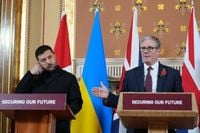In a dramatic escalation of economic pressure on Moscow, the United States and its allies have rolled out sweeping new sanctions targeting Russia’s critical oil sector, banking infrastructure, and access to global capital, signaling a renewed Western resolve as the war in Ukraine grinds into its fourth year. The latest measures, announced on October 22, 2025, by U.S. President Donald Trump, focus on freezing all U.S.-based assets of Russia’s two oil giants—Rosneft and Lukoil—while opening the door to secondary sanctions against foreign banks and companies that continue to do business with these firms.
The move marks the first time during Trump’s second term that his administration has imposed direct sanctions on Russia’s oil industry, a step that follows months of diplomatic wrangling and shifting positions. According to Reuters and Politico, the new sanctions came on the heels of a tense phone call between Trump and Russian President Vladimir Putin on October 17, where a proposed summit in Budapest was ultimately scrapped. Trump, speaking to reporters on Air Force One as he departed for a five-day tour of Asia, made his frustration with Moscow’s negotiating stance clear: “I’m going to have to know that we’re going to have a deal. I’m not going to be wasting my time. I’ve always had a very great relationship with Vladimir Putin, but this has been very disappointing.”
The U.S. Treasury’s Office of Foreign Assets Control (OFAC) confirmed that the sanctions were designed to hit Russia’s war machine where it hurts. “Now is the time to stop the killing and for an immediate ceasefire,” said Treasury Secretary Scott Bessent. “Given President Putin’s refusal to end this senseless war, Treasury is sanctioning Russia’s two largest oil companies that fund the Kremlin’s war machine. Treasury is prepared to take further action if necessary to support President Trump’s effort to end yet another war. We encourage our allies to join us and adhere to these sanctions.”
Rosneft and Lukoil together account for roughly two-thirds of Russia’s daily crude exports, moving about 4.4 million barrels each day, according to Argus media consultancy, as cited by Politico. The new U.S. sanctions freeze any assets held by the companies in the United States and threaten foreign banks with penalties if they facilitate transactions with the blacklisted firms. The measures also extend to dozens of Russian oil refineries, with 11 of the country’s 40 largest facilities—representing 35% of national refining capacity—now under sanctions. Notably, seven of these refineries had already suffered damage from Ukrainian drone strikes earlier this year.
The international response has been swift. The United Kingdom, under Prime Minister Sir Keir Starmer, became the first country to sanction all of Russia’s oil majors last week, and the European Union followed suit with its nineteenth package of sanctions, which includes a ban on Russian liquefied natural gas imports. “We will act to take Russian oil and gas off the global market,” Starmer declared at a coalition meeting in London alongside Ukrainian President Volodymyr Zelensky and NATO Secretary General Mark Rutte. “On Wednesday, the US acted decisively to join us, together with further sanctions from the EU, and we’re choking off funding for Russia’s war machine.”
Allied leaders agreed on a clear plan for the rest of the year to support Kyiv, pledging to increase military and economic pressure on Moscow. The UK also announced an acceleration of its missile production program, with more than 5,000 lightweight multirole missiles slated for delivery to Ukraine, creating 200 new jobs and supporting 700 existing roles at Thales in Belfast. Meanwhile, the EU has frozen about $300 billion of Russia’s central bank foreign reserves since February 2022, and discussions are ongoing about using these frozen assets to purchase American weapons for Ukraine—a move supported by Washington but delayed by legal concerns in Belgium, where most of the funds are held.
Ukraine’s government has been actively lobbying for even tougher measures, including proposals to cut off all Russian banks from the U.S. dollar system. According to Reuters, U.S. officials have indicated support for the EU’s plan to use frozen Russian assets to aid Kyiv, and preliminary discussions are underway about the use of Russian assets located in the United States.
The economic impact of these sanctions is already reverberating through global energy markets. India’s largest refineries are expected to reduce purchases from Rosneft and Lukoil to virtually zero, Bloomberg reported, citing unnamed executives at Indian oil companies. Chinese state-owned oil firms have also suspended purchases of seaborne Russian crude, wary of potential secondary sanctions from Washington. However, analysts cited by The Wall Street Journal believe that Russia will eventually find ways to circumvent the restrictions, possibly by shifting sales to the so-called parallel market or rerouting supplies through countries less exposed to Western financial pressure.
Despite these challenges, Russian officials have downplayed the long-term impact of the sanctions. Kirill Dmitriev, head of Russia’s sovereign wealth fund and a key business negotiator dispatched to Washington, insisted in an interview with Fox News: “Frankly, we do not believe that these sanctions will have a significant impact on the Russian economy because oil prices in the world will rise and Russia will sell just fewer gallons of oil at a higher price. No pressure works on Russia.” Putin himself acknowledged the seriousness of the new restrictions, calling them “an unfriendly act that does nothing to strengthen Russian-American relations.”
On the battlefield, the situation remains fluid. The Russian defense ministry claimed on October 24 that its forces had captured four more villages in eastern Ukraine—Bolohivka in Kharkiv, Promin and Dronivka in Donetsk, and Zlagoda in Dnipropetrovsk. These reported gains come as Ukrainian President Zelensky continues to press Western allies for increased military support and clearer security guarantees. “They want to break Ukraine. They are doing everything to achieve it,” Zelensky told a press conference in London, expressing gratitude for the “shared position on the need to further increase pressure on Russia and continue work with the United States on developing clear and reliable security guarantees for Ukraine.”
Diplomatic efforts have been equally intense. Zelensky was given a ceremonial welcome at Windsor Castle by King Charles, underscoring the symbolic importance of Ukraine’s struggle in the eyes of Western leaders. Meanwhile, the U.S. administration has signaled that it stands ready to ratchet up the sanctions further if Moscow continues to stall on negotiations. “I am ready to do major sanctions on Russia when all NATO nations have agreed, and started, to do the same thing, and when all NATO nations STOP BUYING OIL FROM RUSSIA,” Trump wrote in a pointed message to European allies.
As the world watches the evolving sanctions regime and shifting alliances, one thing is clear: the economic and diplomatic battle over Russian oil is far from over, and its outcome will shape the trajectory of the Ukraine conflict—and the global energy market—for months, if not years, to come.


